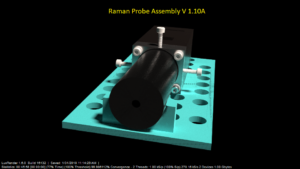3D printing has opened up avenues for so many innovators around the world, allowing for the creation of new parts, pieces, objects, and tools that otherwise may not have been accessible to a variety of designers, engineers, and makers full of ideas. Scientific tools are a great example of this too, as expense is normally such a factor in prohibiting most of the public from being able to use them to see the world in new ways and conduct a variety of experiments.
With the 3D printable raman probe, created by David H. Haffner, Sr., science enthusiasts can create one of the most important components of the raman spectroscope — a tool that allows us to find out more about the material makeup of materials, as one light color is illuminated and gives us information via light interaction with a sample. And with the benefits of 3D printing, makers today are able to enjoy the ability to create such items directly from their own workshops, whenever they want, and make edits at will. They can do so quickly, whether making actual parts for a project or creating rapid prototypes. Affordability is one of the greatest factors of all too, along with the opportunity to experiment with a wide range of materials.
Haffner created this new probe based on a previous project that allowed him to expand his knowledge and create a ‘radical new design concept’ with inspiration from Eduardo H. Montoya R., Aurelio Arbildo L., and Oscar R. Baltuano E., outlined in their paper, “A Homemade Cost Effective Raman Spectrometer with High Performance.”
As a detector, Haffner used a DSLR Nikon D3400 24.2MP Bluetooth camera with the following specifications:
- Effective Pixels (Megapixels) 24.2 million
- Sensor Size. 23.5 mm. x 15.6 mm
- Image Sensor Format. DX
- Storage Media. SD. SDHC
- Top Continuous Shooting Speed at full resolution, with five frames per second
- ISO Sensitivity – ISO 100 – 25,600.
- Movie – Full HD 1,920×1,080 / 60 fps.
- Three-inch monitor
Haffner also used a reflecting mirror, 1800 mm/gr diffraction grating holographic (as the spectrometer), and two fiber optic cables. Here you can find information regarding the probe assembly, laser collimation tube and assembly, along with the blueprints and build instructions. This 3D printed raman probe is still a work in progress, and Haffner is providing updates. Check out instructions for assembly here as well as reading about his more recent changes to the concave mirror, as he resolved several issues.
If you have continued interest in raman probes and spectroscopes, you can find out more here (downloading an entire booklet of information from the science technology experts at Renishaw), or read one of our previous articles about 3D printed components that also make raman spectroscopy more accessible.
What do you think of this news? Let us know your thoughts; join the discussion of this and other 3D printing topics at 3DPrintBoard.com.
[Source/Images: Hackaday]
Subscribe to Our Email Newsletter
Stay up-to-date on all the latest news from the 3D printing industry and receive information and offers from third party vendors.
You May Also Like
3D Printing Financials: Fathom Struggles in Financial Quicksand During Critical Transition
Facing a year of key transitions and financial pressures, Fathom (Nasdaq: FTHM) has filed its annual report for 2023 with the U.S. Securities and Exchange Commission (SEC). The document outlines...
Latest Earnings Overview for Australian 3D Printing Firms Titomic and AML3D
Australian 3D printing manufacturing firms Titomic (ASX: TTT) and AML3D (ASX: AL3) reported their financial results for the period from July to December 2023, marking the first half of their...
3D Printing Webinar and Event Roundup: April 7, 2024
Webinars and events in the 3D printing industry are picking back up this week! Sea-Air-Space is coming to Maryland, and SAE International is sponsoring a 3D Systems webinar about 3D...
3D Printing Financials: Unpacking Farsoon and BLT’s 2023 Performance
In the Chinese 3D printing industry, two companies, Farsoon (SHA: 688433) and Bright Laser Technologies, or BLT (SHA: 688333), have recently unveiled their full-year earnings for 2023. Farsoon reported increases...




































